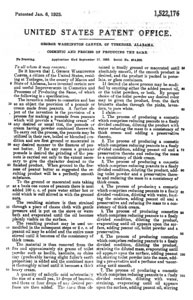 On January 6, 1925, George Washington Carver was granted patent #1,522,176 for a cosmetic and processing of producing the same. This cosmetic was a cream made from peanuts. In the patent, Carver describes this as a “vanishing cream of any desired or usual tint.”
On January 6, 1925, George Washington Carver was granted patent #1,522,176 for a cosmetic and processing of producing the same. This cosmetic was a cream made from peanuts. In the patent, Carver describes this as a “vanishing cream of any desired or usual tint.”
Carver has been credited with discovering over three hundred different uses for peanuts and hundreds of different uses for soybeans, pecans and sweet potatoes. His discoveries include bleach, fuel briquettes, instant coffee, synthetic rubber and wood stain. Despite all of these inventions, Carver only applied for and was granted three patents. His other two patents were #1,541,478, granted on July 9, 1925 and #1,632,365 granted on July 14, 1927 for paints and stains produced from clay. Continue reading “Who Received a Patent For Cosmetics Made Out Of Peanuts?”



 On October 7, 1952 Bernard Silver and Norman Joseph Woodland received US Patent 2,612,994 for “Classifying Apparatus and Method.”
On October 7, 1952 Bernard Silver and Norman Joseph Woodland received US Patent 2,612,994 for “Classifying Apparatus and Method.”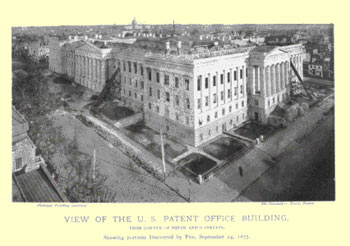 The Patent Office had its second fire on September 24, 1877. This fire happened in the new “fire-proof” building whose construction had begun in 1836. The building was fireproof but the contents were anything but.
The Patent Office had its second fire on September 24, 1877. This fire happened in the new “fire-proof” building whose construction had begun in 1836. The building was fireproof but the contents were anything but. The monetary lose was much worse than that of the fire in 1836. For months after the fire, great efforts were made at a very high cost to replace the artifacts. Of the 114,000 models that were housed in the building, 87,000 were destroyed. 600,000 prints of original drawings were lost and had to be reprinted. Original drawings and models of 31 patents were destroyed. These were restored using only the specifications. Ultimately though, no patents were completely lost in the fire.
The monetary lose was much worse than that of the fire in 1836. For months after the fire, great efforts were made at a very high cost to replace the artifacts. Of the 114,000 models that were housed in the building, 87,000 were destroyed. 600,000 prints of original drawings were lost and had to be reprinted. Original drawings and models of 31 patents were destroyed. These were restored using only the specifications. Ultimately though, no patents were completely lost in the fire.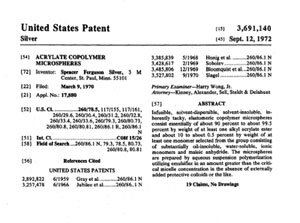 Sometimes an inventor will make a best selling product completely be accident. The Post It Note is an example of that. In 1968, Dr. Spencer Silver invented a repositionable adhesive that was strong enough to stick to surfaces but did not leave any residue. Silver had not set out to produce such a glue. He was actually trying to make a very strong adhesive. Patent Number #3691140 for Acrylate Copolymer Microspheres, the adhesive used on Post It Notes was granted to Spencer Ferguson Silver on March 9, 1970. But 3M never utilized this adhesive.
Sometimes an inventor will make a best selling product completely be accident. The Post It Note is an example of that. In 1968, Dr. Spencer Silver invented a repositionable adhesive that was strong enough to stick to surfaces but did not leave any residue. Silver had not set out to produce such a glue. He was actually trying to make a very strong adhesive. Patent Number #3691140 for Acrylate Copolymer Microspheres, the adhesive used on Post It Notes was granted to Spencer Ferguson Silver on March 9, 1970. But 3M never utilized this adhesive. 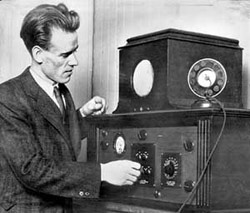 Philo Taylor Farnsworth was an American inventor born August 19, 1906. He was best known for inventing the first fully electronic television system, including the first working electronic image pickup device (video camera tube), and for being the first to demonstrate fully electronic television to the public.
Philo Taylor Farnsworth was an American inventor born August 19, 1906. He was best known for inventing the first fully electronic television system, including the first working electronic image pickup device (video camera tube), and for being the first to demonstrate fully electronic television to the public.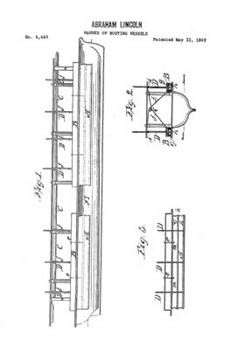 Abraham Lincoln received patent #6469 on May 22, 1849 for a device to lift boats over shoals. His device was never manufactured but he did become the only president to hold a patent.
Abraham Lincoln received patent #6469 on May 22, 1849 for a device to lift boats over shoals. His device was never manufactured but he did become the only president to hold a patent.